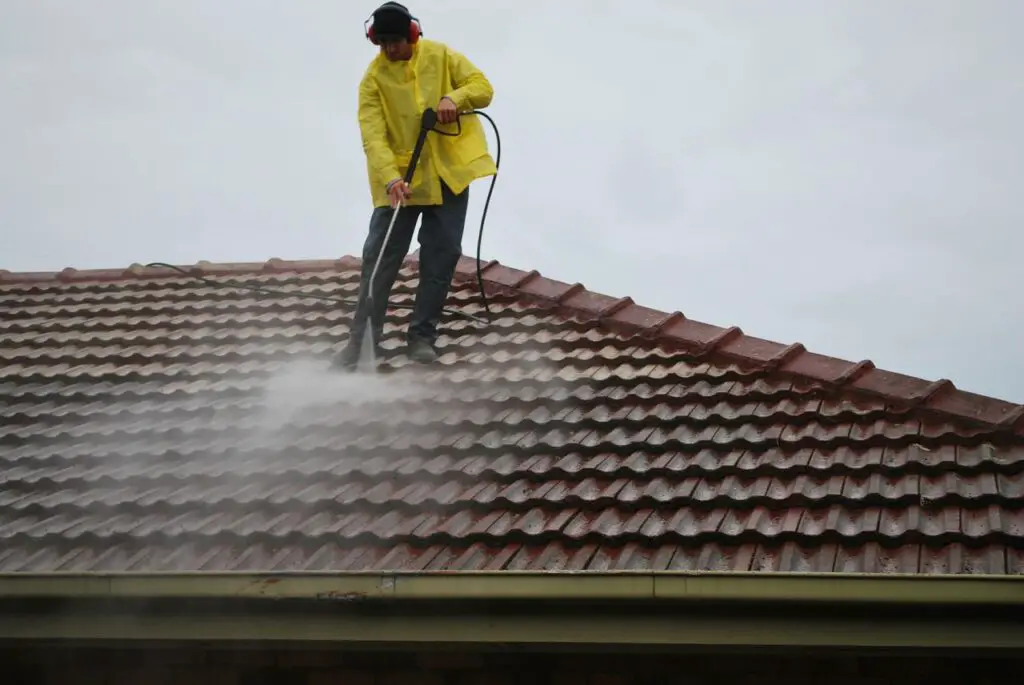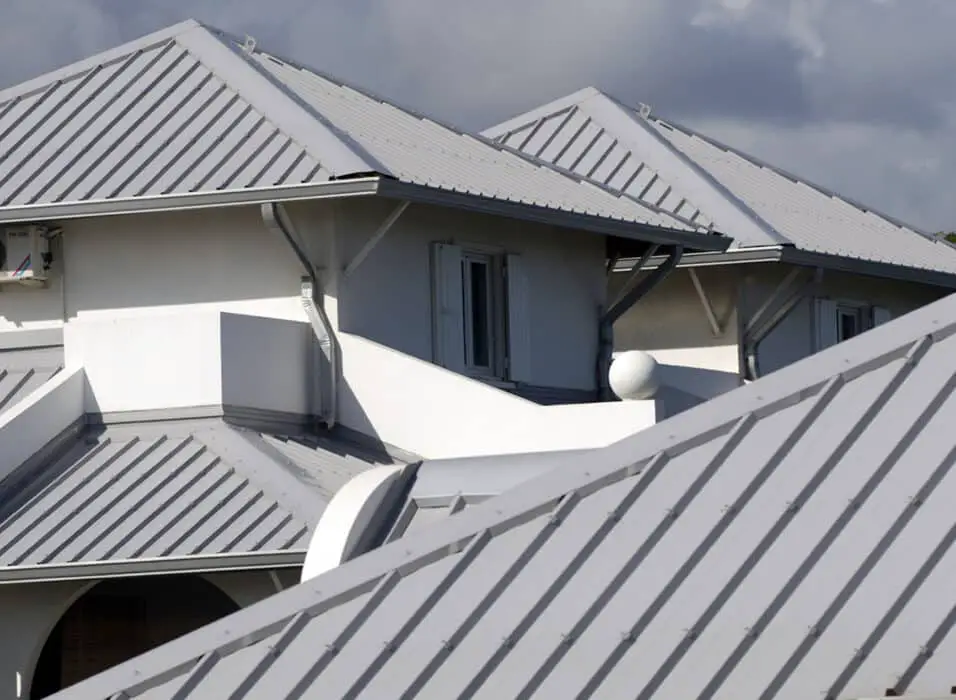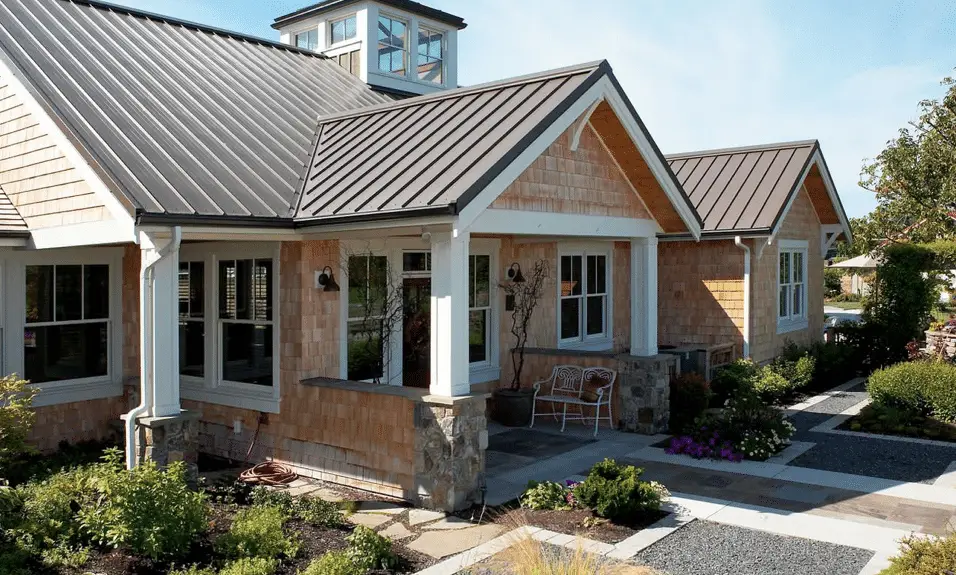How To Clean Metal Roof With Pressure Washer
Introduction
How To Clean Metal Roof With Pressure Washer: A pressure washer is a powerful tool that can effectively remove dirt, grime, and organic growth from your metal roof. However, it is crucial to use the pressure washer correctly to avoid causing any damage. Additionally, ensure that all gutters and downspouts are clear to prevent any clogs during the cleaning process.
When using a pressure washer, it is important to adjust the pressure settings appropriately. Start by testing the pressure on a small, inconspicuous area of the roof to ensure that it does not cause any damage. Once you have determined the appropriate pressure, work in small sections, moving the nozzle in a sweeping motion to evenly clean the surface.
By following these instructions and taking the necessary precautions, you can effectively clean your metal roof using a pressure washer. Remember to prioritize safety by wearing appropriate protective gear, such as goggles and non-slip shoes, and to be mindful of your surroundings to avoid accidents. With regular maintenance and cleaning, your metal roof will not only look pristine but also continue to protect your home for years to come.

Is it safe to use pressure washer on metal roof?
You’ll cause scratches and other damage to your panels with products like that. Avoid them at all costs!
Benefits of using a pressure washer on a metal roof:
Pressure washing can be an effective method for removing dirt, debris, moss, and other contaminants from a metal roof. It can restore the roof’s original appearance and improve its overall longevity. The high-pressure water stream can reach areas that are difficult to access manually, ensuring a thorough cleaning. Additionally, pressure washing can save time and effort compared to traditional cleaning methods.
Potential risks of using a pressure washer on a metal roof:
The high-pressure water stream can damage the metal roof if not used correctly. Excessive pressure or improper technique may cause dents, scratches, or even dislodge protective coatings. Moreover, if water penetrates through gaps or damaged areas, it can lead to leaks and water damage inside the building. Therefore, caution and proper preparation are essential when using a pressure washer on a metal roof.
Precautions to take when pressure washing a metal roof:
Before using a pressure washer on a metal roof, it is important to take certain precautions to minimize the risks. Firstly, inspect the roof for any existing damage, loose screws, or missing panels. Repair any issues before proceeding with pressure washing. Secondly, adjust the pressure washer to a low or medium setting to avoid excessive force. It is advisable to start with the lowest pressure and gradually increase if necessary. Additionally, use a wide-angle spray nozzle to distribute the water evenly and reduce the chances of causing damage. Lastly, maintain a safe distance from the roof surface while operating the pressure washer to prevent accidental damage.
What is the best cleaner for a metal roof?
Special Metal Roof Cleaning Circumstances
- Mix: 1/3 cup of powdered laundry detergent + 1 quart of bleach (5% solution) + 3 quarts of water.
- Dip a soft brush or rag in the cleanser and apply to affected areas.
- Lightly scrub the surface until the area is free of mildew or mold.
- Rinse the surface well with plain water.
Introduction:
A metal roof is a durable and long-lasting option for homeowners. However, like any other roofing material, it requires regular maintenance to ensure its longevity and appearance. One crucial aspect of maintaining a metal roof is cleaning it properly. Regular cleaning not only enhances the roof’s aesthetic appeal but also prevents the buildup of dirt, debris, and potential damage.
Choosing the best cleaner for a metal roof:
This solution is gentle enough not to damage the metal surface while effectively removing dirt and grime. It is important to avoid using harsh chemicals or abrasive cleaners that can scratch or corrode the metal.
Regular cleaning is vital for maintaining the longevity and appearance of a metal roof. By choosing the appropriate cleaner and using gentle cleaning methods, homeowners can ensure their metal roofs remain in optimal condition.
What chemical is used to pressure wash a roof?
Sodium Hypochlorite (bleach)
The Role of Sodium Hypochlorite:
Sodium hypochlorite, commonly known as bleach, is a chemical compound that is widely used as a disinfectant and cleaning agent. When used in pressure washing, it acts as a powerful oxidizing agent that helps to break down and remove organic stains on the roof’s surface.
Benefits of Using Sodium Hypochlorite:
Another benefit of using sodium hypochlorite is its affordability and availability. It is a relatively inexpensive chemical that can be easily obtained from hardware stores or cleaning supply retailers. Additionally, it is compatible with most pressure washing equipment, making it a convenient choice for roof cleaning professionals.
Precautions and Considerations:
While sodium hypochlorite is an effective chemical for pressure washing roofs, it is important to take certain precautions and considerations. Firstly, it is essential to wear protective gear, such as gloves and goggles, when handling and applying the chemical to avoid any potential skin or eye irritation. When used correctly and with proper precautions, it can help restore the appearance and extend the lifespan of roofs. However, it is always advisable to consult professionals or follow manufacturer guidelines to ensure the safe and efficient use of sodium hypochlorite for roof cleaning.
What is the best way to clean a roof?
The ARMA recommends a 1:1 ratio of bleach to water to clean a roof. They also advise against using a pressure washer on asphalt shingles, as the force of the water can damage them. After being allowed to sit on the roof surface for up to 20 minutes, the bleach solution should be rinsed away with clean water.
Cleaning a roof is an essential maintenance task that helps to prolong its lifespan and maintain its appearance. However, it is crucial to approach roof cleaning with caution to avoid causing any damage. There are several methods available for cleaning a roof, each with its own advantages and disadvantages.
Methods for Cleaning a Roof:
One of the most common methods for cleaning a roof is pressure washing. This technique involves using a high-pressure water spray to remove dirt, debris, and stains from the roof’s surface. Pressure washing can be effective in removing stubborn grime, moss, and algae. However, it is important to use the appropriate pressure setting and technique to prevent damage to the roof’s shingles or tiles.
Another method for cleaning a roof is chemical cleaning:
This method involves using specialized cleaning solutions or chemicals to remove dirt, stains, and biological growth from the roof’s surface. Chemical cleaning can be particularly effective in removing moss, algae, and lichen. However, it is crucial to follow the manufacturer’s instructions and safety guidelines when using these chemicals. Protective gear, such as gloves and goggles, should be worn to prevent any harm to the skin or eyes. Additionally, it is important to thoroughly rinse the roof after applying the cleaning solution to avoid any residual damage.
Preventive Measures:
Regular maintenance and preventive measures can significantly reduce the frequency and intensity of roof cleaning. One effective preventive measure is the installation of zinc or copper strips along the roof’s ridge. These metal strips release ions that inhibit the growth of moss, algae, and lichen. Additionally, keeping the roof free from debris, such as leaves and branches, can prevent the accumulation of moisture and organic matter that can promote the growth of biological organisms.
Cleaning a roof is an important task that should be approached with care. Pressure washing and chemical cleaning are two common methods for cleaning a roof, each with its own advantages and considerations. It is crucial to follow the appropriate techniques and safety guidelines to avoid causing any damage. Implementing preventive measures, such as the installation of metal strips and regular debris removal, can help to reduce the need for frequent roof cleaning. By taking these steps, homeowners can ensure a clean and well-maintained roof that enhances the overall appearance and longevity of their property.
Which chemical is best for roof?
Polymer-based coatings:
Polymer-based coatings, such as polyurethane or acrylic, are highly durable and can provide long-lasting protection against water damage. They are often applied as liquid membranes and can be used for various types of roofs.
When it comes to maintaining the integrity and longevity of your roof, choosing the right chemical is crucial. The roof is constantly exposed to various environmental factors such as rain, snow, UV rays, and pollution, which can cause damage over time. Therefore, it is essential to select a chemical that not only protects the roof but also enhances its durability. In this article, we will explore some of the best chemicals for roofs and their benefits.
Chemical 1: Acrylic Roof Coatings
One of the most popular choices for roof protection is acrylic roof coatings. These coatings are made from a water-based formula that forms a seamless, protective layer over the roof surface. Acrylic roof coatings offer several advantages, including excellent UV resistance, flexibility, and durability. They can effectively reflect sunlight, reducing the heat absorbed by the roof and minimizing energy costs. Additionally, acrylic coatings are easy to apply and maintain, making them a cost-effective solution for roof protection.
Chemical 2: Silicone Roof Coatings
Silicone roof coatings are another excellent option for roof protection. These coatings are known for their exceptional durability and resistance to extreme weather conditions. Silicone coatings create a seamless membrane that prevents water penetration and protects the roof from leaks and moisture damage. They also offer excellent UV resistance, preventing premature aging and deterioration of the roof. Silicone roof coatings are highly flexible, allowing them to expand and contract with temperature changes, ensuring long-lasting protection for your roof.
Chemical 3: Polyurethane Roof Coatings
Polyurethane roof coatings are widely recognized for their superior waterproofing properties. These coatings create a seamless, elastic membrane that provides excellent protection against water infiltration. Polyurethane coatings are highly resistant to ponding water, making them ideal for flat or low-slope roofs. They also offer exceptional durability and can withstand harsh weather conditions. Additionally, polyurethane coatings provide excellent adhesion to various roofing materials, ensuring long-term protection for your roof.
Chemical 4: Asphalt Roof Coatings
Asphalt roof coatings are commonly used for protecting asphalt shingle roofs. These coatings are made from a blend of asphalt and other additives, providing a protective layer that extends the life of the roof. Asphalt coatings offer excellent waterproofing properties, preventing water penetration and protecting against leaks. They also provide UV resistance, reducing the risk of sun damage and fading. Asphalt roof coatings are easy to apply and can be an affordable option for roof protection.
Choosing the right chemical for your roof is essential for its long-term protection and durability. Acrylic, silicone, polyurethane, and asphalt roof coatings are some of the best options available in the market. Each of these chemicals offers unique benefits, such as UV resistance, flexibility, and waterproofing properties. Consider the specific needs of your roof, climate conditions, and budget when selecting the best chemical for your roof. Regular maintenance and inspections are also crucial to ensure the continued effectiveness of the chosen chemical and to extend the lifespan of your roof.
How can I ensure that the pressure washer is used correctly and safely on a metal roof?
When using a pressure washer to clean a metal roof, it is crucial to follow proper safety measures and techniques to avoid any potential risks or damages. Firstly, it is important to ensure that you have the appropriate equipment for the job. Use a pressure washer with adjustable pressure settings and a nozzle specifically designed for delicate surfaces like metal roofs. This will allow you to control the water pressure and minimize the risk of causing dents or other damage to the roof.
Before starting, thoroughly inspect the metal roof for any loose or damaged areas. Repair or secure them before using the pressure washer to prevent further damage. It is also advisable to cover any nearby plants, windows, or delicate surfaces with plastic sheeting or tarps to protect them from the high-pressure water and cleaning solutions.
When operating the pressure washer, maintain a safe distance from the roof surface to prevent accidental damage. Start with a low-pressure setting and gradually increase it if necessary. Avoid using excessive pressure, as it can strip off protective coatings or paint from the metal roof. Additionally, always aim the nozzle downwards to prevent water from getting trapped under the roof panels, which can lead to leaks or corrosion over time.
Are there any specific cleaning solutions or detergents that should be used in conjunction with a pressure washer for cleaning a metal roof?
When using a pressure washer to clean a metal roof, it is important to choose the right cleaning solutions or detergents to ensure effective and safe cleaning. Using the wrong cleaning agents can potentially damage the metal surface or even cause harm to the environment.
It is recommended to use mild, non-abrasive cleaning solutions or detergents specifically designed for use with pressure washers and suitable for metal surfaces. These solutions are typically formulated to remove dirt, grime, and stains without causing any harm to the metal roof. Avoid using harsh chemicals, bleach, or acidic cleaners as they can corrode the metal and compromise its integrity.
Before applying any cleaning solution, it is advisable to test it on a small, inconspicuous area of the metal roof to ensure compatibility and to check for any adverse reactions. Additionally, always follow the manufacturer’s instructions and guidelines for the specific cleaning solution or detergent being used.
What are the recommended pressure settings or PSI (pounds per square inch) for effectively cleaning a metal roof with a pressure washer?
When it comes to cleaning a metal roof with a pressure washer, it is crucial to use the correct pressure settings or PSI (pounds per square inch) to ensure effective cleaning without causing any damage. The recommended pressure settings for cleaning a metal roof typically range between 1,200 and 1,500 PSI. It is important to note that using excessive pressure can lead to dents, scratches, or even punctures in the metal surface, while insufficient pressure may not effectively remove dirt, debris, or stains.
Before starting the cleaning process, it is advisable to test the pressure washer on a small, inconspicuous area of the metal roof to determine the appropriate pressure setting. This will help you gauge the impact of the pressure on the roof and make any necessary adjustments. Additionally, it is recommended to use a wide-angle spray nozzle rather than a narrow one, as a narrow spray can concentrate the pressure on a smaller area, increasing the risk of damage.
While pressure settings are important, it is equally crucial to maintain a safe distance between the pressure washer nozzle and the metal roof. Keeping a distance of around 12 to 18 inches ensures that the water pressure is spread out and reduces the risk of causing any harm to the roof. Regularly inspecting the roof for any signs of damage or weak spots before cleaning is also essential to prevent further issues.
Are there any specific techniques or tips for avoiding streaks or damage while using a pressure washer to clean a metal roof?
When using a pressure washer to clean a metal roof, it is important to follow certain techniques and tips to avoid streaks or damage. Firstly, it is recommended to use a wide-angle spray nozzle instead of a narrow one. This helps to distribute the water evenly and reduces the chances of leaving streaks on the roof. Additionally, it is crucial to maintain a safe distance between the pressure washer nozzle and the roof surface. Keeping a distance of around 12 to 18 inches ensures that the water pressure is not too intense, preventing any potential damage to the metal roof.
Another technique to avoid streaks is to clean the roof in sections, working from the top down. This allows you to control the flow of water and ensures that any dirt or debris is washed away properly. It is also advisable to clean the roof on a cloudy day or during cooler hours to prevent the water from drying too quickly, which can lead to streaks. Furthermore, using a cleaning solution specifically designed for metal roofs can help in removing stubborn stains and preventing streaks. However, it is important to carefully read and follow the manufacturer’s instructions when using any cleaning solution.

Conclusion
Cleaning a metal roof with a pressure washer can be an effective and efficient way to maintain its appearance and prolong its lifespan. By following the proper instructions and taking necessary precautions, homeowners can achieve impressive results without causing any damage to the roof or surrounding areas.
First and foremost, it is crucial to understand the importance of using the right pressure setting on the pressure washer. Additionally, using a wide-angle spray nozzle can help distribute the pressure evenly and prevent any concentrated force on a specific area.
Furthermore, it is essential to use the appropriate roof cleaning solution when pressure washing a metal roof.It is important to read the instructions carefully and dilute the cleaner as recommended before applying it to the roof.
When pressure washing a metal roof, it is also crucial to take safety precautions. Wearing protective gear, such as goggles and gloves, can prevent any injuries from debris or cleaning solutions. Additionally, it is advisable to cover nearby plants and shrubs with plastic sheets to protect them from any potential damage caused by the cleaning solution or high-pressure water.
Pressure washing a metal roof can be an effective method to keep it clean and well-maintained. By following the proper instructions, using the right pressure setting and cleaning solution, and taking necessary safety precautions, homeowners can achieve impressive results. Regularly cleaning a metal roof not only enhances its appearance but also helps prevent any potential damage caused by dirt, grime, or mildew.








